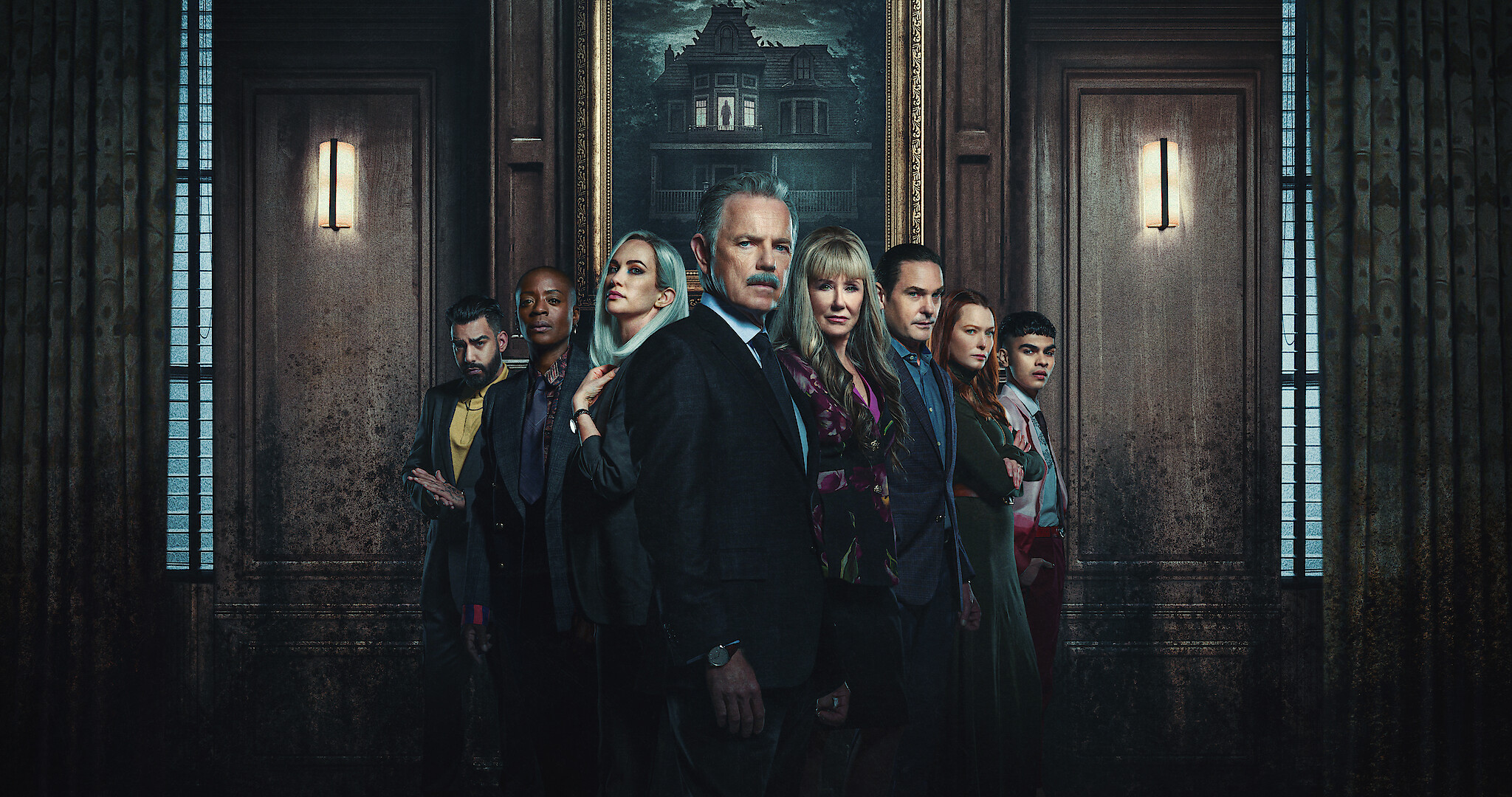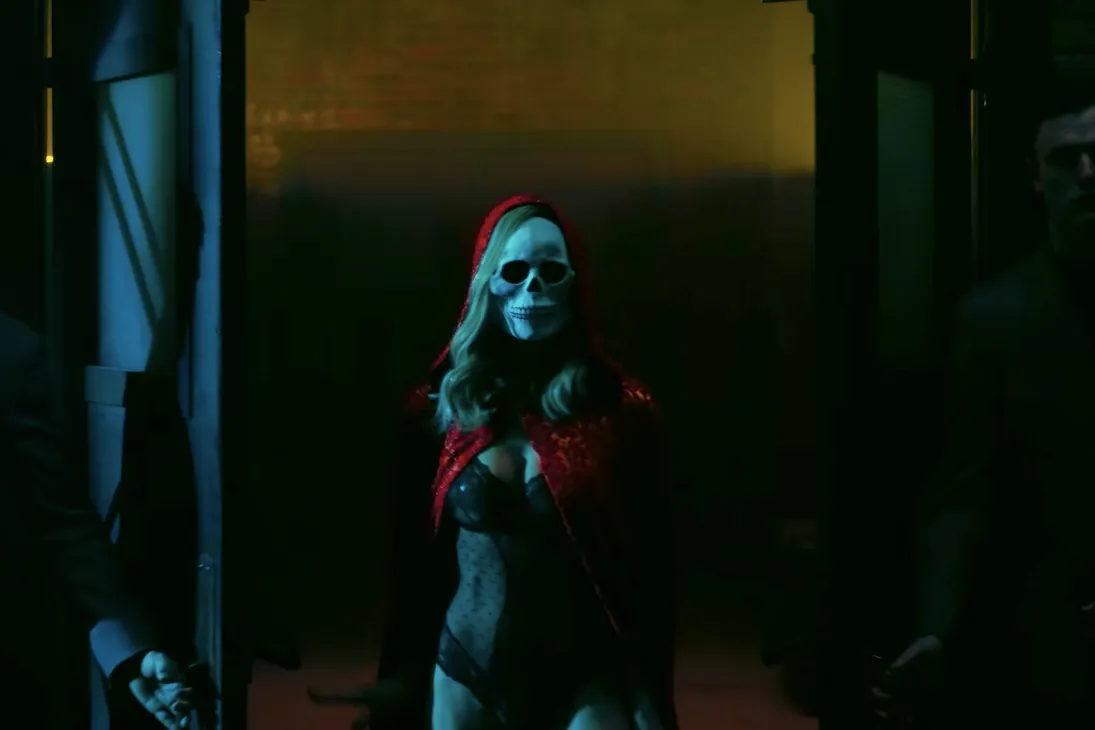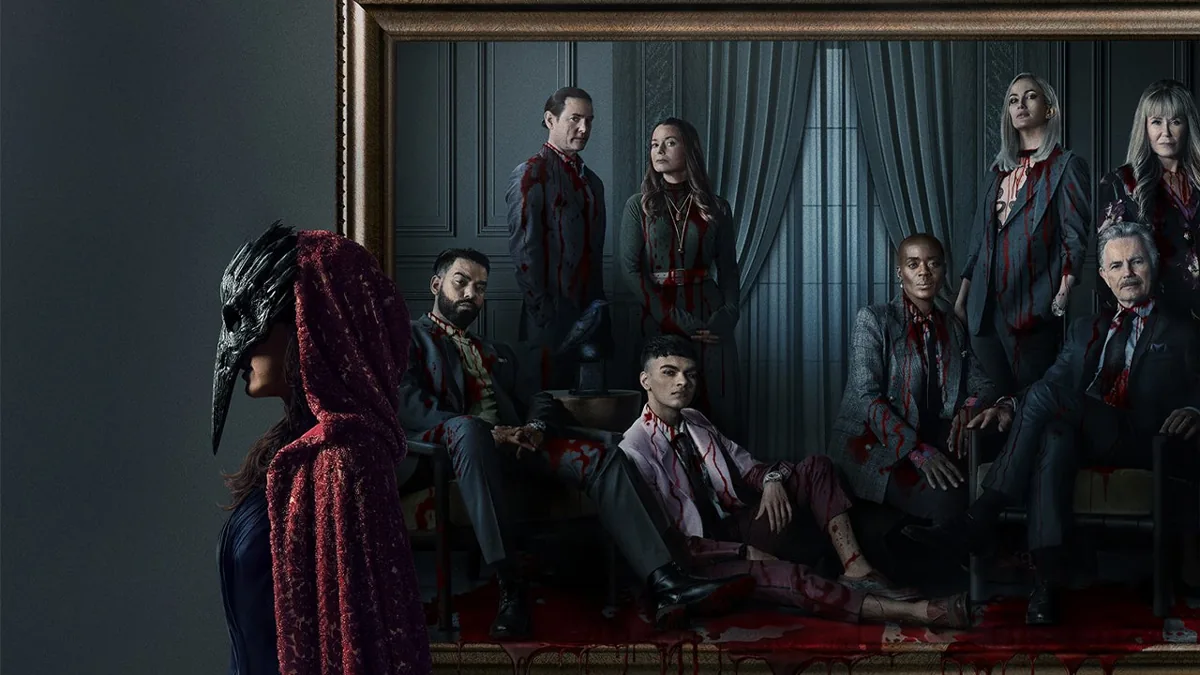Spoiler Alert: This article contains plot details and analysis for the Netflix miniseries The Fall of the House of Usher (2023).
Contrary to the title’s suggestion; the Netflix miniseries The Fall of the House of Usher isn’t just based on the short story of the same name by Edgar Allan Poe. It draws from the wider body of Poe’s work including references and plot points from a huge variety of his stories. It’s like an Easter Egg hunt through nineteenth-century Gothic literature which is, for some of us [ie: me], an extremely specific jam.
Edgar Allen Poe (1809-1849) wrote satires, articles, literary criticism, and stories for a number of genres. But he is undoubtedly best known for his tales of horror. Many of his stories have become lynchpins of modern horror conventions and references to Poe or his work can be found littered throughout popular culture. He cemented his status as a horror icon by dying in mysterious circumstances, that have never been fully explained, in 1849 at the relatively young age of forty.
This is by no means an exhaustive list of all the references to Poe’s work found in The Fall of the House of Usher. It might not even be complete, but it (hopefully) covers some of the most significant references and a few of the more obscure.
This is also another spoiler warning. If you haven’t watched The Fall of the House of Usher and think you might, there are absolutely spoilers coming.
What’s in a Name?
We begin with the source material. The Fall of the House of Usher is a short story first published in 1839 featuring Roderick and Madeleine Usher (the main characters of both show and story). In the story, Roderick invites the narrator to his decaying family home where he reveals the fate of himself and his sister. This forms the basic framework of the show where we see Roderick orating the story of his family and how they came to meet their gruesome fates. As if to demonstrate how much the show draws on Poe’s larger bibliography; with the exception of the first episode each episode shares a name with one of Poe’s short stories. The first episode on the other hand, is ‘A Midnight Dreary‘ which forms part of the opening lines of arguably Poe’s most famous work, The Raven (1845).
Once upon a midnight dreary, while I pondered, weak and weary…
In the same vein, the characters, beyond Roderick and Madeleine, are all taken from Poe’s work as are the plotlines leading (for the most part) to their eventual demise. While the name of Roderick Usher might be from The Fall of… his character resembles the young man from Poe’s The Landscape Garden (1842) which has a poet inheriting an incredible amount of money leading him away from his poetry.
Frederick Usher (feat. Morrie and Lenore)
The name Frederick is taken from the short story Metzengerstein (1832) which features a young man named Frederick as the sole heir to the family fortune and estate. It ends badly for both Fredericks.
Frederick’s wife Morella or ‘Morrie’ is taken from Poe’s story Morella (1835) and their daughter Lenore is another reference to The Raven.
Eagerly I wished the morrow;—vainly I had sought to borrow
From my books surcease of sorrow—sorrow for the lost Lenore—
For the rare and radiant maiden whom the angels name Lenore—
Nameless here for evermore.
Tamerlane ‘Tammy’ Usher (feat. William ‘Bill-T’ Wilson)
Tamerlane is the name of one of Poe’s earlier poems which he initially published anonymously. The poem features the eponymous Tamerlane (also known as Timur), a fourteenth-century Turco-Mongol conqueror. Historically, Tamerlane founded an empire and was an accomplished and successful military commander. The poem however presents Tamerlane as having achieved great success at the cost of his one great love whom he spurned; themes we can see throughout Tammy’s character.
Her husband William Wilson or ‘Bill-T’ comes from the story William Wilson (1839) which heavily inspires Tammy’s fate.
Victorine ‘Vic’ Lafourcade
Mademoiselle Victorine Lafourcade appears in the opening of The Premature Burial (1844). Her burial before she was actually dead is one of the examples the narrator uses to illustrate his fear of being buried alive.
Napoleon ‘Leo’ Usher
The inspiration for Leo’s name is taken from one of Poe’s non-horror stories. It comes from the comedy The Spectacles (1844) wherein the main character, Napoleon Bonaparte Froissart, (no prizes for guessing where that name comes from) accidentally “marries” his eighty-two year old grandmother because his vanity prevents him from wearing the titular spectacles.
Camille l’Espanaye
Taken from The Murders in the Rue Morgue (1841), Camille l’Espanaye is one of two victims brutally murdered in a case that baffles local police. Her character’s name is directly tied up to her literary counterpart so more on that later.
Prospero ‘Perry’ Usher
Like Camille, Perry’s name, character, and fate are tied up with his eponym; Prince Prospero who appears in The Masque of the Red Death (1842). Also like Camille, we’ll pick up with Prospero later.
Annabel Lee
Roderick’s first wife is named for Poe’s poem of the same name; Annabel Lee (1849). Many of the lines recited by Roderick to her are taken from the poem itself. While both Annabel Lees die young, the subject of the poem remains beloved by the narrator for the rest of his life.
C. Auguste Dupin
Dupin first appeared in The Murders in the Rue Morgue and is an example of one of the first fictional detectives. His character went on to inspire other literary greats such as Sherlock Holmes and Poirot, but the way in which Poe wrote him, namely with a narrator following the action from the sidelines, would also inspire the foils of Doctor John Watson and Poirot’s Captain Arthur Hastings.
Arthur Gordon Pym
Mark Hamill’s character is taken from Poe’s one and only novel; The Narrative of Arthur Gordon Pym of Nantucket (1838). The backstory of Pym in the show draws heavily from The Narrative… showing a young Pym travelling the world including references to the Hollow Earth theory and Pym’s reluctance to discuss his adventures in the Arctic.
Rufus Wilmot Griswold
Unlike the other characters, Griswold is not drawn from Poe’s fiction. He was, however, a genuine person who knew Poe himself. In life, Griswold was an abrasive, unpleasant anthologist who built his career on intentionally negative reviews. He built up an infamous reputation for being savage and malicious in his critiques of poetry and its writers, which included Poe.
Their relationship was strained and after Poe’s death, Griswold managed to obtain the rights to Poe’s literary estate. This was shortly after he published an anonymous obituary that defamed and dragged Poe and his reputation. Though he published anthologies of Poe’s works and collected the income for himself, Griswold also devoted the remainder of his life to slandering Poe by publishing an inaccurate memoir which portrayed him at various times as a drunk, addict, madman, and sometimes all three. Even after it was revealed to be a lie, Griswold’s memoir became the primary source for Poe’s biographers for the next generation. Despite his obvious issues with Poe, portraits of him decorated Griswold’s home alongside Griswold’s own image.
Fortunato
Although not the name of a character, Fortunato, the empire upon which the house of Usher has built its success, appears as a nobleman in The Cask of Amontillado (1846). This story forms the basis of its CEO Rufus Griswold’s fate.
Henry Longfellow
The original CEO of Fortunato is also drawn from Poe’s life. Henry Wadsworth Longfellow was a contemporary of Poe. Initially one of Poe’s literary heroes, Poe would go on to accuse Longfellow of plagiarism. For six weeks Poe published letters denouncing Longfellow but received no reply. Unlike many poets of the time, Longfellow was popular in life rather than death and could afford to ignore the criticism without a loss of reputation.
Eliza
The mother of Roderick and Madeleine is only known as Eliza, a dominant and religious presence in her children’s lives until her slow death by illness. Eliza was the name of Poe’s mother as well as the middle name of Poe’s wife; Virginia Eliza Clemm. They were first cousins and married when she was thirteen and he fourteen years older at twenty-seven. Both Eliza and Virginia died of tuberculosis after a long and drawn-out illness. Their loss is thought to have inspired much of Poe’s works that deal with the loss of a young and beautiful woman, including The Raven. The loss of his beloved wife and Poe’s subsequent depressive reaction is seen throughout the poem Annabel Lee.
Plots and Other References
In the interests of brevity, I won’t be giving any extensive details of plot lines as they occur in the show. Instead, I will just be presenting the works that they’re drawn from. The connections and influences should be pretty obvious.
E2: The Masque of the Red Death
The second episode of the series is one of the most directly influenced by its source material. In the original story, we see Prince Prospero gathering an exclusive crowd of the ultra-rich and wealthy. They retreat behind the stone walls of an abbey in order to ride out the Red Death; a plague that is sweeping through their people, killing them en masse and quickly.
During a masquerade ball, Prospero is visited by a figure in ghoulish garb who seems to taunt him but no matter how close Prospero gets, the figure manages to elude him at every turn. When he finally catches him, Prospero falls down dead and it’s revealed that despite their efforts to escape, the Red Death has entered the abbey. With the doors welded shut, the guests cannot escape and each of them contracts the plague. By morning, all of them are dead, still gathered for revelry.
E3: Murder in the Rue Morgue
The third episode follows the fate of Camille l’Espanaye, the Usher family’s PR and spin doctor. Her eponym in The Murders in the Rue Morgue meets the same grisly end when she is assaulted and ripped apart by an aggressive orangutan. For the Camille of the show, the setting is the RUE laboratory, while the original Rue Morgue is a fictional French street invented for the story.
E4: The Black Cat
Another almost direct telling of Poe’s titular story of 1843 though we’ve already seen that “Leo” (Napoleon Usher) comes from an entirely different story. Unlike Leo, the narrator of The Black Cat loves animals and keeps a black cat named Pluto. His relationship with animals deteriorates when he descends into alcoholism ultimately leading him to gouging out one of Pluto’s eyes before killing him outright.
Filled with remorse, he goes on to adopt another black cat with the same characteristics as Pluto. This cat doesn’t like him and repeatedly attacks him until the narrator attempts to kill the cat with Thor’s hammer an axe. The story ends with him murdering his wife and the police finding her body with the cat sitting atop it to alert them as opposed to the show which has Leo falling to his death in an attempt to finally end the cat.
E5: The Tell-Tale Heart
The Tell-Tale Heart (1843) is one of Poe’s more well-known stories and the premise is pretty simple, reflected in the show. The narrator murders his housemate and conceals the body under the floorboards. Having heard a commotion, a neighbour summons the police but the narrator feigns innocence. That is until the persistent beating of the dead man’s heart beneath the floorboards drives the narrator to insanity and confession.
E6: Goldbug (feat. William Wilson)
The Goldbug (1843) story doesn’t influence the episode of its name as directly as the others. In Goldbug a gentleman by the name of William Legrand finds a bug that resembles a scarab that is entirely made of pure gold. Believing this scarab will mean the recovery of the family fortune, Legrand becomes increasingly obsessed with finding the fortune associated with the scarab while those around him wonder if he’s gone insane.
The episode draws from Goldbug through Tammy’s venture of the same name which features a golden scarab but her eventual end is taken from a different story; that of William Wilson. Here, the character of William Wilson meets a boy with the same name who seems to take on William’s traits which irritates the hell out of William. Everywhere William goes, his double follows now wearing the same clothes and seemingly having changed his face to match. Having been thwarted in his plans repeatedly by his double, William ultimately attacks, resulting in him being fatally stabbed beside a mirror.
E7: The Pit and the Pendulum (feat. Berenice)
The Pit and the Pendulum (1842) only loosely inspires the episode that takes its name. In fact, the only similarity between the two is that there is a pendulum involved. The narrator of the story manages to escape the pendulum before it slices into him whereas the show’s Frederick isn’t so lucky.
The episode is a little more inspired by Berenice (1835) the plot of which can be seen in Frederick’s relationship with his wife, Morrie. The beautiful Berenice suffers from bouts of catalepsy, leaving her aware of the world around her but unable to interact with it. Her husband, the narrator, is increasingly obsessed with her, especially her teeth. Believing his wife to have died, he extracts her teeth and stores them in a small box, only to find that she is not dead at all.
Shout out to the poem Verna speaks to Madeleine; Poe’s The City in the Sea (1850). Verna hopes that the poem will bring Madeleine clarity while the initial poem is thought to suggest that the material world is worse than hell and the force of death might be worse than the devil.
E8: The Raven (but mostly The Cask of Amontillado)
We see a lot of Poe’s most famous work The Raven in the final episode, not least in the presence of an actual raven which seems to haunt the remaining Ushers. At one point it even sits atop a bust of Pallas a la the poem. This episode also shows us the loss of Lenore and includes repeated ‘Nevermore’ references’ as well as lines from the poem itself.
And the Raven, never flitting, still is sitting, still is sitting
On the pallid bust of Pallas just above my chamber door;
And his eyes have all the seeming of a demon’s that is dreaming,
And the lamp-light o’er him streaming throws his shadow on the floor;
And my soul from out that shadow that lies floating on the floor
Shall be lifted—nevermore!
Far more obvious are the references to The Cask of Amontillado which sees the narrator taking revenge against his rival, Fortunato. Having lured Fortunato into an underground catacomb with the promise of sampling amontillado wine, the narrator chains Fortunato within an alcove and begins walling him inside. In the show, the victim is Rufus Griswold, who mimics Fortunato’s reaction beginning with screaming for help and ending with making offers of a deal but to no avail. The story takes place during a carnival with Fortunato depicted as wearing a jester’s costume.
The final scenes of Roderick and Madeleine return to the original source material for their end. Like their literary counterparts, Madeleine attacks Roderick as the house collapses around them. The narrator who had listened patiently to Roderick’s story this whole time escapes in time to see the house fall completely, collapsing in on itself and killing the Usher siblings.
Honourable Mention: The Legend of Twosret
Egyptian iconography is seen throughout The Fall of the House of Usher and Madeleine Usher is referred to, on several occasions, as Cleopatra or a goddess. Twosret or Tausret was a pharaoh who acted as regent for her husband’s heir until he too died and she continued to reign as pharaoh in her own right. It was a short-lived reign and doesn’t appear in any of Poe’s short stories. The legend of her twin sapphires seems to be made up for the show as Twosret had a greater connection to the stone turquoise which was mined heavily in her reign.
The Fall of the House of Usher is currently streaming on Netflix.
If you’d like to join me for behind the scenes fun you can find me at my Patreon.















